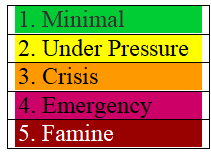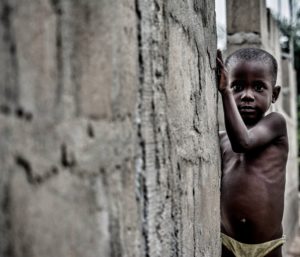The first quarter of 2017 was marked by a food crisis affecting approximately fifteen countries, of which four of these regions are suffering from severe famine.
The United Nations has sounded the alarm.
What is famine?
We all have a more or less concrete idea of what it is, but it is not as obvious to answer this question because its definition must be accepted by all of the organizations that come to aid those who are victims of famine.
Since 2004, a number of tools and processes have been established, allowing “to analyze and classify the severity of food insecurity following international, scientific standards.” The IPC (Integrated Food Security Phase Classification) is a standardized scale that classifies acute food insecurity according to five phases (IPC info, n.d.).

According to the IPC, famine is declared when the following conditions are met:
• more than 30% of children are suffering from acute malnutrition;
• 2 deaths per 10,000 residents are recorded every day;
• a pandemic disease has been declared;
• residents have access to less than 4 liters of water per day;
• their food intake provides less than 2100 calories per day;
• and civil conflicts and large-scale population displacements are observed (Knowles-Coursin, 2017).
Which countries are affected?
Yemen, South Sudan, Nigeria, and Somalia are currently threatened with a “humanitarian catastrophe.” And children are the first victims. The numbers are dramatically significant. According to the United Nations, famine threatens more than 20 million people in these four regions, 1.4 million of which are children who are at risk of dying of malnourishment.
 In South Sudan, there are 280,000 children suffering from the most severe form of acute malnutrition. In Nigeria, in the states affected by the conflict, 450,000 children are affected. In Yemen, 2.2 million children are suffering from acute malnutrition, with 462,000 of them severely affected. In Somalia, 185,000 children have been affected and the numbers are dangerously increasing (Gonzales, 2017).
In South Sudan, there are 280,000 children suffering from the most severe form of acute malnutrition. In Nigeria, in the states affected by the conflict, 450,000 children are affected. In Yemen, 2.2 million children are suffering from acute malnutrition, with 462,000 of them severely affected. In Somalia, 185,000 children have been affected and the numbers are dangerously increasing (Gonzales, 2017).
Famine is spreading and threatening the sub-regions. Families who are fleeing from violence and the lack of food are seeking refuge in already vulnerable bordering countries. Since the beginning of 2017, more than 60,000 South Sudanese people have fled to neighboring Sudan (Blavignat, 2017). In addition, Ethiopia, Kenya, the Lake Chad Basin, and Uganda are showing alarming levels of food insecurity.
A situation caused by climatic conditions and exacerbated by armed conflicts
South Sudan has been going through a civil war since December 2013, which has caused tens of thousands of deaths and displaced more than three million people. Thousands of women and children cross the Ugandan border every day. “Persistent conflicts ravage the lives of millions of children and families. The belligerents force people to leave their homes, destroy crops and other means of subsistence as well as impede the efforts of humanitarian organizations […]” (Modola, 2017).
Before the war, Yemen purchased 90% of its food abroad. The importation route is completely blocked by the conflict. The problem is mainly political. In Nigeria, millions of people have abandoned their homes and fields to flee the atrocities of Boko Haram or the retaliations of the Nigerian army.
 Somalia is experiencing drought for the fourth consecutive year and it is linked to the armed conflicts that have ravaged the country for more than twenty years. The situation is alarming. “At the end of February, the Somalian government declared a state of national disaster.” (Macé, 2017). Generally, “if drought is an aggravating factor, famine is always caused by people and major political crises” (Pierre Mendiharat, Director of Operations for Doctors Without Borders) (Longuet, 2017).
Somalia is experiencing drought for the fourth consecutive year and it is linked to the armed conflicts that have ravaged the country for more than twenty years. The situation is alarming. “At the end of February, the Somalian government declared a state of national disaster.” (Macé, 2017). Generally, “if drought is an aggravating factor, famine is always caused by people and major political crises” (Pierre Mendiharat, Director of Operations for Doctors Without Borders) (Longuet, 2017).
In addition to this, there is the crucial problem of accessing drinking water. At the end of March, UNICEF warned about the lack of access to clean water. More than 5 million people are deprived of clean water in South Sudan, Nigeria, Somalia, and Yemen. “Shortages of safe water, the lack of adequate sanitation facilities and poor hygienic conditions pose additional risks to children suffering from malnutrition and are likely to trigger fatal diarrhea. (Manuel Fontaine, Director of Emergency Programs at UNICEF) (Blavignat 2017).
A Difficult Battle
In the face of this urgent and extreme situation, UNICEF’s Sébastien Lyon confirms that the main obstacle is access to the population. “For example, in northern Nigeria, Boko Haram is preventing our teams from getting to the population; our trucks are blocked. As a result, all efforts to respond to these crises are reduced to nothing.” (Gouëset, 2017).
An amount of 864 million dollars has been deemed necessary to stop this crisis, but the UN states that only 31% of this sum has been raised (Le Monde, 2017). In the field, UNICEF provides children with emergency care, treatment for malnutrition, vaccines, drinking water, and sanitation facilities as well as mobile health and nutrition services to help the affected families. To prevent children from becoming the first victims of famine, it is necessary and urgent to end human rights violations and harmful policies.
written by : Enaëlle Deschamps translated by : Tyanna Williams Proofread by : Priyanka Lindgren |
IPC info (n.d) Integrated Food Security Phase Classification. Disponible sur : http://www.ipcinfo.org/fileadmin/templates/ipcinfo/Docs/IPC_Facsheet_FR.pdf
Knowles-Coursin. (31/03/2017) Qu’est-ce que la famine? [article d’information en ligne] récupéré sur Unicef : https://www.unicef.fr/dossier/famine
Gonzales, F. (03/04/2017) Alerte famine : plus de 1,4 million d’enfants en danger de mort [article d’information en ligne], récupéré sur Unicef : https://www.unicef.fr/article/alerte-famine-plus-d-14-million-d-enfants-en-danger-de-mort
Blavignat, Y. (29/03/2017) Confronté à la famine, le Soudan du Sud fait face à un exode massif [article de journal en ligne] récupéré sur Le Figaro : http://www.lefigaro.fr/international/2017/03/29/01003-20170329ARTFIG00238-confronte-a-la-famine-le-soudan-du-sud-fait-face-a-un-exode-massif.php
Modola, (03/04/2017) 5 choses à savoir sur la famine et les enfants [article d’information en ligne] récupéré sur Unicef : https://www.unicef.fr/article/5-choses-savoir-sur-la-famine-et-les-enfants
Macé, C. Big Infographie, (20/03/2017) Crise alimentaire : Soudan du Sud, Somalie, Nigeria et Yémen au bord du gouffre [article de journal en ligne] récupéré sur Libération : http://www.liberation.fr/planete/2017/03/20/crise-alimentaire-soudan-du-sud-somalie-nigeria-et-yemen-au-bord-du-gouffre_1556119
Longuet, M. (23/03/2017) Famine en Afrique : comment en est-on arrivé là? [article de journal en ligne] récupéré sur Le Parisien : http://www.leparisien.fr/international/famine-en-afrique-comment-en-est-on-arrive-la-22-03-2017-6785892.php
Blavignat, Y. (29/03/2017) Confronté à la famine, le Soudan du Sud fait face à un exode massif [article de journal en ligne] récupéré sur Le Figaro : http://www.lefigaro.fr/international/2017/03/29/01003-20170329ARTFIG00238-confronte-a-la-famine-le-soudan-du-sud-fait-face-a-un-exode-massif.php
Gouëset, C. (02/04/2017) Pourquoi la famine n’a pas disparu en Afrique et au Yémen [article de journal en ligne] récupéré sur L’Express : http://www.lexpress.fr/actualite/monde/afrique/pourquoi-la-famine-n-a-pas-disparu-en-afrique-et-au-yemen_1894338.html
Le Monde (23/03/2017) L’ONU peine à recueillir des fonds pour lutter contre la famine en Somalie [compte-rendu de journal en ligne] récupéré sur Le Monde : http://www.lemonde.fr/afrique/article/2017/03/23/l-onu-peine-a-recueillir-des-fonds-pour-lutter-contre-la-famine-en-somalie_5099184_3212.html

